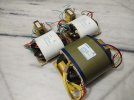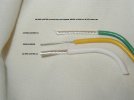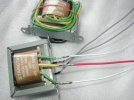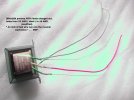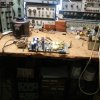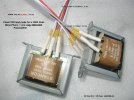3-28-21 ..... MINI UPDATE ..... WITH NO SEXY PHOTOS
Quite unusual, two near-retirement age audiophiles are having me to build a copy of my new Direct Couple tube amp, for their own use. It is the first time I am ever doing such a thing. In all the decades of my amp building, it was always " for my own use ", not for resale.
I found that
double series shunting the B+ to critical areas of the amp, was
not quite good enough, fidelity wise. What does work to my extreme satisfaction is a
four section filter topology to these sensitive areas. This takes extra parts ( it takes an L/C and L/C in series, two additional sections, placed before the two SHUNTS in series ).
One of the changes we will all see, will be to the prototype chassis seen so far, in this thread. It's size will be
enlarged by two inches side to side, 1 ¼ inches front to back, and 3/8ths of an inch in depth. All the re-dimensioning will allow parts to fit inside reasonably well. I will have to rebuild my own amp, and now, two additional. Fine.
Three other of my trusted
longtime audiophile friends want to DIY build this circuit, so I am now responsible, in one way or another, for
six of these DC 6005 SE stereo amps.
Saturday, 3-27-21, a dozen Softone RW-20 SE R-Core output transformers were International Air Priority FEDEX shipped to me, from Yokohama, Japan. Happy news.
Two weeks ago, I finalized the circuit design with the Softone RW-20 output transformers in place. I have the Direct Couple exactly where I want it ( voltage and current-wise ). Both tubes are operating individually and jointly as one optimized “ centered ” circuit. Many pages of measurements, for each small resistor value change, documented what was found eventually to be ideal. When you change a resistor value in a directly coupled amplifier, many things change !! The amp will operate and track nicely over varying line input voltages, and the tubes will long-term operate conservatively and reliably.
I have decided to make my main B+ power transformer a
custom R-Core, as well as the filament transformer for the stereo amps' double 5U4GB tube rectifiers. These two R-Core power transformers will offer several unique advantages, with sonic consequences. ( Lower distortion ). As soon as I obtain the core sizes from the custom R-Core winder, I will have precise dimensions to specify a new chassis.
Now I plan to have all six chassis plasma cut, of heavy 14 gauge steel, including holes for the tube sockets, the transformer mounting, and ventilation / cooling holes. Each chassis will have four welded corners, and be powder coated.
This 6005 stereo directly-coupled amplifier is intended for my personal long term use, on ALTEC VOTT A7-8 speakers. That always was ….. the original intent.
This DIY amplifier design is
unique in many ways. Allow me to spell them out to you please, so you might understand.
1) Use of
lower distortion custom R-Core transformers, for the
power supply and the
output transformers
2) Use of
dual and directly-heated tube rectifiers
3) Use of two-in-series
six Ohm low DCR power supply chokes ( L1/C1/L2/C2 ) to the Finals
4) Use of two
1,500 Ampere capable GTO power supply caps, for razor-sharp / leading edge transient delineation.
5) Use of
film caps throughout, and
fully-developed multiple film cap bypassing in critical locations
6) Use of extensive wire lead
augmentations, with wire having silver content
7) Use of three separate
phase-aligned power transformers, for the B+, the tube rectifiers' ( a big deal ) and driver tubes' filaments
8) Use of a
two-stage directly coupled circuit. A
Russian 6N23Pi into a
USA beam tetrode 6005. Detente..... in 2021.
9) Use of
no Negative Feedback with a
tetrode Finals stage amplifier, and short silver-content wire paths
10) A separate driver and separate G2 B+ supply with passive
quadruple R/C filters, and shunt filters, in series ( an awesome thing ).
11) Use of
conservative tube operating points, typically at 62% ( Golden Ratio ) or less of their maximum rated plate dissipations
12) Use of
higher voltage driver tube operation, over 200 VDC on it's plate, ( at reduced current ) so the circuit swings the music's input signal voltage freely - with a certain
unique sense of liveliness
13) Use of two tubes, selected such that their “ theoretical ” mu when multiplied,
approaches 400. This is the
best way we know, from our direct experience, to have a sense of
“ jump factor ” in a tube amp's music presentation. An amp with a good " jump factor:" is more mentally involving to hear. It offers the uncanny sense of "You are there ", right at the original recording site, and hearing things in the real time of the music.
14) Use of a
low-resonance 14 gauge all steel chassis, powder coated, with welded corners and an “ Isolation Platform ” engineered bottom cover.
15) Use of a 6005 tube, which has
a symmetrical construction, a
round plate, cathode, grid structure, tightly and symmetrically spaced to each another . ( without four corners, there are no “sneak feedback” electron paths possible ).
16) Use of
resistor choices,
proven already as being sonically desirable . Caddock, Roderstein, etc etc.
Because of all of the above ( 16 ) design factors, I fully expect the new amplifier design to play back music
“ world-class ”, and to hopefully
set new standards in one's listening, with high efficiency speakers.
No one has
ever implemented a 6005 tube in this above manner !! All of this is the culmination of four decades of my own DIY tube amplifier building. It keeps me
mentally motivated, to execute this as well as I can. This Single Ended tube amp should be
a great deal of fun to hear and experience on 101 dB ( and above ) full range speakers !!
Thanks for your time today, for reading my laundry list - and allowing me the freedom of expression, to share my expectations . Time will tell.

drlowmu


